Archived Fire Damage Blog Posts
Why Choose SERVPRO for your home restoration project?
2/15/2022 (Permalink)
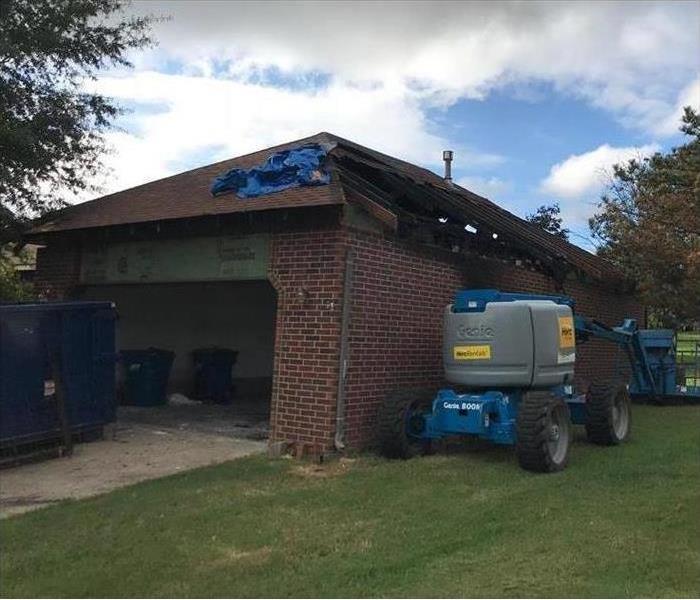 Call SERVPRO of Springfield/Greene County today to get started, 417-865-7711.
Call SERVPRO of Springfield/Greene County today to get started, 417-865-7711.
Every construction project is unique, we would like to give you a more in depth look at the processes used at SERVPRO of Springfield/Greene County to give you the best experience.
Pre-Construction Phase:
- Approvals and Estimates: Before your project can begin, you will need to make sure you have secured all the required approvals. SERVPRO of Springfield/Greene County may be able to assist you with some of these approvals. We use the Xactimate estimating software for all construction projects and will provide a copy of your estimate as an attachment to your Construction Work Authorization.
Construction Phase:
- During this phase we will Schedule tradesmen, arranging access to your home and communication scheduling constraints, this is critical to an efficiently run project. At a minimum you will receive weekly communication from SERVPRO of Springfield/Greene County. We will provide information on the status of your project, discuss recently completed work and address any questions you may have. At each phase our Construction Project Manager will inspect work in progress to make sure the work is completed correctly and that any work that is incomplete is addressed quickly.
Post Construction Phase:
- All workmanship and materials for work performed will conform to industry standards defined in the Residential Construction Performance Guidelines for Professional Builders and Remodelers, Fifth Addition. Once all work has been completed you will be asked to sign a Certification of Completion.
SERVPRO of Springfield/Greene County will be there to guide you through the process and work with your insurance company to make sure this process is as seamless as possible. If you have damage to your home, we have everything you need to complete your home construction project. Let us be your one-stop shop for your home construction project. With one phone call, our highly trained professionals will oversee your home construction project from start to finish. Call SERVPRO of Springfield/Greene County today to get started, 417-865-7711.
Preventing Pet Fires in your Springfield Home
2/15/2022 (Permalink)
 Protect your pet by preventing home fires in your Springfield home.
Protect your pet by preventing home fires in your Springfield home.
For many homeowners their pets are considered part of the family. You might be surprised at how much damage your beloved pet can cause to your home and property.
According to the National Fire Protection Association nearly 1,000 home fires are started each year by the homeowner’s pets, this affects over 500,000 pets. The AKC and ADT Security offer some tips we thought they would be good to share:
- Extinguish Open Flames- Pets are generally curious and will investigate cooking appliances, candles, or even a fire in your fireplace. Ensure your pet is not left unattended around an open flame and make sure to thoroughly extinguish any open flame before leaving your home.
- Remove Stove Knobs- Be sure to remove stove knobs or protect them with covers before leaving the house - a stove or cook top is the number one piece of equipment involved in your pet starting a fire.
- Invest in Flameless Candles- These candles contain a light bulb rather than an open flame, and take the danger out of your pet knocking over a candle. Cats are notorious for starting fires when their tails turn over lit candles.
- Secure Young Pets - keep them confined away from potential fire-starting hazards when you are away from home such as in crates or behind baby gates in secure areas.
There are other ways to help prepare for such disasters, it’s a good idea to include your pets in your family emergency plan. Discuss your plan with your family members and determine who is responsible for grabbing your pets during an emergency. Always keep collars on your pets in case firefighter need to rescue your pet. When leaving your pet home alone, keep them in areas near the entrances of your home. A pet alert window cling is a good idea, you can identify the number of pets in your home. Sometimes even with all the preparation and planning in place mishaps happen.
At SERVPRO of Springfield/Greene County each year we see many home disasters caused from these cute little furry family members that we all love. From cats turning on water faucets to dogs jumping up and turning on the stove burners, if this happens to your family rest assured the professionals at SERVPRO of Springfield/Greene County know what to do, call us 24/7/365 days a year at 417-865-7711.
SERVPRO Gives Back
2/8/2022 (Permalink)
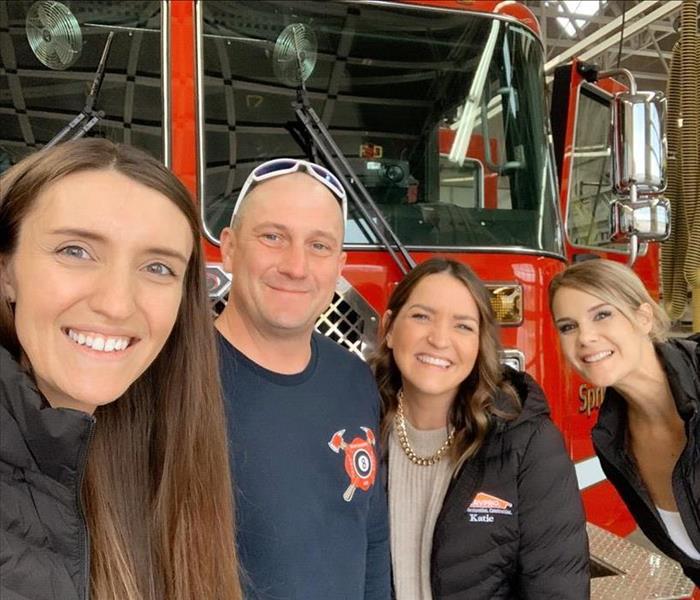 Our Marketing Team Visiting one of the local fire stations in January of 2022.
Our Marketing Team Visiting one of the local fire stations in January of 2022.
In January of 22 the SERVPRO of Springfield/Greene County marketing team consisting of our Marketing Manager Katie and our Account Managers, Anna and Amberlyn visited over 25 different Fire Stations in Springfield and Branson area to hand out over 50 goodie bags and cases of bottled water to the stations. We hope that they feel the love and appreciation we have for their public service. Our community is very important to us. For that reason, we take every opportunity we can to give back to our southwest Missouri community. It’s our way of letting our neighbors know that we’re HERE TO HELP no matter what happens. Follow along with us on our social media channels for more stories of giving back to our community.
Debunking 4 Fire Sprinkler Myths
10/1/2021 (Permalink)
There’s no denying a fire could cause devastating damage to your Greene County commercial property. And without a way to extinguish the flames quickly, some of your workers and customers could be severely injured or killed. That's why having a commercial fire sprinkler system is vital.
According to the National Fire Protection Association (NFPA), when sprinklers are installed, the chances of dying in a fire are diminished by 80 percent and the average property loss due to fire is cut by 50 to 66 percent, compared to fires where there are no sprinklers.
While it’s unquestionable that sprinklers are crucial tools for defense against fires, there are still many misconceptions about how sprinklers truly work. So, let’s talk about 4 common myths concerning commercial fire sprinkler systems and why they’re wrong.
Myth 1: Water Damage Produced by Sprinklers Cost More Than Fire Damage
FACT: Sprinkler systems are more cost-effective when compared to the damage caused by other firefighting efforts. Since sprinklers can keep a fire contained within one room rather than allowing flames and smoke to spread through a building, most fire damage cleaning is reduced to one area. Additionally, water damage as a result of fire hoses regularly costs more to restore. Sprinklers discharge only 8-24 gallons of water per minute, while fire hoses gush 50-125 gallons per minute.
MYTH 2: All Sprinkler Heads Discharge During a Fire
FACT: Sprinkler heads are designed to only respond to fire temperatures above 155 °F. A temperature-sensitive glass bulb filled with a liquid or metal alloy hold fire sprinkler heads in place. The glass applies pressure to a pipe cap, stopping water from streaming through the system. So, only sprinkler heads close to a fire will be set off, leaving unaffected areas dry.
MYTH 3: Sprinklers are Too Sensitive
FACT: Although you want your sprinkler system to be sensitive to fires, that doesn’t mean they will be set off by somebody burning their lunch or lighting a cigarette. Only 1 in 16 million sprinkler heads trigger by accident, so their benefits far overshadow any risks.
Myth 4: Smoke Alarms Activate Sprinkler Systems
FACT: Fire sprinkler systems and smoke alarms function separately. Smoke alarms detect smoke particles which causes them to alarm. This is very important, because you want a warning before a fire has extended too far. But sprinkler system heads are only heat activated. The one will not set off the other.
As a business owner, you’re aware that safety is needed to keep your operations running smoothly. To help ensure your Greene County company will be safer from fire damage, it’s a good idea to install commercial sprinklers and mount fire extinguishers throughout your facility.
But if the unexpected does occur, help is nearby. At SERVPRO of Springfield / Greene County, we’re both fire damage and water damage clean up professionals. We offers 24-Hour Emergency Recovery Services and are committed to getting your business back on its feet as quickly as possible.
Even Tobacco Smoke Odor is Hazardous
9/24/2021 (Permalink)
Have you ever bought or rented a home in southwest Missouri that had been completely restored yet sometimes you could still smell cigarette smoke? That’s because after years of smoking, even the bones of a house can be infused with tobacco odor, leaving unpleasant smells in all rooms, not just where someone has smoked. SERVPRO of Springfield / Greene County knows how strong these odors can get. We have to work just as hard to eliminate smoke odor as we do house fire malodors.
Why tobacco smoke is such a big problem
Cigarette smoke leaves a yellowish-brown, gluey residue that sticks to all surfaces of a home, making it difficult and time-consuming to remove. If you have ever cleaned walls or windows that have been exposed to cigarette smoke, then you’ve likely seen this residue.
According to the American Lung Association, cigarettes contain over 7,000 chemicals (40 of which are associated with cancer) that not even the strongest air purifier can eliminate from your home. But it’s not just an odor problem.
How tobacco smoke affects your home
Studies conducted by the San Diego State University indicate that third-hand smoke from walls, carpets and curtains can have a significant impact on a person’s health. Toxic and volatile compounds from cigarettes build up in drywall and in soft furnishings. Children, in particular, are at risk of disease caused by exposure to the toxins from third-hand smoke.
“There’s a big illusion that when tobacco smoke disappears, we’re safe,” said SDSU psychology professor Georg Matt, director of the resource center. “Unfortunately, some of the most toxic compounds clinch to surfaces. They get embedded in carpets, they coat walls, they penetrate into walls. They become part of the indoor environment.”
Smoking not only affects the people exposed to smoke, but it also produces odorous substances that stick to every surface of the area where smoking has taken place. The yellowish-brown substance eliminated through smoking bonds to walls, furniture, and plastics, and can permanently change their appearance. Cigarette smoke also penetrates more odor-absorbing objects, such as insulation, carpets, upholstery, bedding, clothes, and many more.
Additionally, a buildings HVAC system carries smoke odor and chemicals throughout the structure. That means that the buildup of dust and debris inside the ducting that absorbed those odors needs to be removed and the entire ducting system will need to be thoroughly cleaned and sanitized.
How professionals remove tobacco smoke odor
There is no magic formula that removes these residues and malodors.
Masking odors with air fresheners only works temporarily and may pose health risks. Moreover, covering up tobacco smell with a fresh coat of paint without cleaning or using a primer first won’t effectively eliminate the odor. Within a short period of time, smoke residue will begin leaking through the paint and spread offensive odors through the room, just like before.
The only effective way to remove tobacco residue and odor is with a very thorough cleaning then sealing of all structural surfaces. SERVPRO of Springfield / Greene County, your southwest Missouri restoration specialists, begin tobacco smoke removal by cleaning all surfaces, using deodorizers to eliminate every tiny particle of tobacco smoke. Once we’ve cleaned all visible surfaces, we use specific equipment (such as hydroxyl generators and/or ozone generators) that abolish the odor molecules that are inaccessible, such as inside walls and ducting.
We next use a sealant that locks in stains and odors. After that, surfaces will be made ready to refinish, paint, or apply new coverings. Finally, our team confirms that all surfaces have been sanitized and treated to ensure odors stay away from you and your property.
SERVPRO of Springfield / Greene County are professionals at removing smoke residue and odors, no matter their source. So don’t continue to suffer from unwelcome odors and stains. Let us provide your home with a breath of fresh air!
Biohazard Cleanup – What, When and Why?
9/24/2021 (Permalink)
When you hear the word “Biohazard”, what comes to mind? You may think of situations such as the current COVID-19 pandemic. But biohazards also stem from traumatic events where blood, human or animal residues, chemical spills, and more are involved. They include these scenarios:
Biohazard cleanup involves cleaning, sanitizing, and deodorizing areas where such traumatic events have occurred. Cleanup after these events is a serious business that not just anyone can handle. The threats involved caused by bacteria, viruses, and infectious diseases can put your health and safety at risk. Frequently, these pathogens are invisible, making cleanup an even more problematic task for the inexperienced.
You may think that if the police are involved, someone else will clean up the aftereffects. But the state of Missouri isn’t responsible for cleaning up crime scenes. After police investigators collect evidence from a scene, it’s up to the property owner to hire a biohazard remediation company like SERVPRO of Springfield / Greene County. But we can arrive onsite only after the police have gathered enough evidence related to the crime.
SERVPRO of Springfield / Greene County is trained in the cleanup and remediation of all types of trauma situations. We have a team of highly professional experts who have experience in these matters who follow proper training and safety procedures. We specialize in fast and thorough cleanup work to ensure the safety and security of everyone involved.
Does Biohazard Cleanup Require Certification?
To become a biohazard technician, obtaining certification is not required. However, the Occupational Safety and Health Administration (OSHA) does require biohazard technicians to properly wear personal protective equipment (PPE) when dealing with bloodborne pathogens, because every time technicians handle potentially hazardous materials they’re put at significant risk.
The SERVPRO of Springfield / Greene County team employs state-of-the-art protective equipment and cleanup processes that follow strict safety protocols outlined by OSHA and EPA. Furthermore, we provide up-to-date bioremediation training for technicians that includes best practices, proprietary methods, and safety compliance.
The SERVPRO Biohazard Cleanup Process
- We start cleanup efforts as quickly as possible.
- We remove all potentially infectious materials from the site.
- Hazardous medical waste is handled in compliance with OSHA regulations. It’s then processed and sent to a licensed hazardous medical waste incinerator.
- Technicians remove porous materials like fabric and carpeting following industry standards and Missouri state regulations.
- Non-hazardous materials are either removed or decontaminated and sanitized if they are considered salvageable.
- After cleanup and sanitization, affected areas are deodorized, and walls and flooring may be sealed to cover any remaining stains from the incident.
SERVPRO strives to be exceptionally sensitive to these situations by showing extra care and compassion and we do our best to understand that those involved may be emotionally vulnerable.
As with any type of property damage, SERVPRO of Springfield / Greene County restoration professionals ensure that their actions don’t worsen the sense of loss of the property owners. Before we’re able to arrive on the scene, follow these tips to protect yourself and your property.
Fire Extinguisher Safety Tips
11/9/2020 (Permalink)
There are many preventative measures you can take to reduce the risk of fire damage in your home, such as smoke detectors, an evacuation plan, and a fire safety kit. If a large fire breaks out, you’ll need to call the fire department and wait for help. But certain small fires may not require outside assistance and can be put out with a fire extinguisher. But before you do, the following is information that you need to know.
Find Your Fire Extinguisher
It’s smart to know the location of your fire extinguisher before a fire breaks out and you’re stuck without it. Everyone who resides in your home, whether family members or roommates, also need to know where it is. Your fire extinguisher(s) should be hanging on the wall in plain sight so that no one has to go searching for it in an emergency. Kitchens, laundry rooms, and garages are the best places to store them because heat sources and flammable chemicals are most present in those rooms.
If you don’t own a fire extinguisher, buy one immediately. They come in a variety of sizes and prices and should be affordable by all. If your rent, some states and towns, including Springfield, state that landlords must provide a portable fire extinguisher and that they properly maintain it.
Inspect Your Fire Extinguisher
It is important to regularly inspect your fire extinguisher to make sure it’s in working order because the worst time to discover it isn’t is during a fire. Check the inspection tag for the date your fire extinguisher was last inspected to judge if it needs another one. To work correctly, the gauge’s needle should only point to the green “charged” zone. Otherwise, it needs to be recharged
If you find cracks in the hose, or if it’s too brittle to bend easily, get it replaced. Be sure the pin is securely tied to the extinguisher with a safety tether. Other damages, such as corrosion, dents, and leaking, will require replacement of the unit.
Use Your Fire Extinguisher
Everyone in your home or business needs to know how to use a fire extinguisher before an emergency. Go to a safe, isolated, outside area to practice. It is highly recommended that you use the P.A.S.S. technique to operate your fire extinguisher:
First, pull the pin and break the tamper seal on the fire extinguisher. Second, aim the extinguisher nozzle low at the base of the fire. Third, squeeze the handle to release the extinguishing agent. Finally, sweep back and forth until the fire is completely out.
(If you have any doubts in your ability to operate a fire extinguisher during a fire, evacuate the premises instead.)
Cleanup and Recharge Your Fire Extinguisher
Since the extinguishing material in most fire extinguishers is a dry chemical, you can use a vacuum cleaner to remove any remaining residue once the fire is out. The extinguishant is similar in texture to sand, so you should be able to remove most of it. Once the loose residue is picked up, use a damp rag to scrub up whatever is left. Be sure to keep your hands protected because the chemical can potentially damage your skin.
Even if you only discharged a little of the fire extinguisher, the cylinder still needs to be replaced or refilled. If you don’t, it won’t be able to help protect you if another fire breaks out. Call your landlord or a local, licensed fire protection company to recharge it.
Contact Us
If your Missouri home or building has sustained fire damage, contact SERVPRO of Springfield / Greene County immediately. Our trained fire damage restoration professionals use advanced equipment and cleaning products to clean and restore your property, ensuring that your home or business is returned to its original condition or better.
What to Do If Caught in a House Fire
9/4/2020 (Permalink)
Raging flames rip through your home – a terrifying sight we at SERVPRO of Springfield Greene County hope you never have to experience. But the reality is that thousands of residential fires occur in the U.S. every year, over 326,000 last year alone! The causes vary from cooking accidents (#1) to heaters, cigarettes, washers and dryers, BBQ grills, candles and more. Here are tips to escape a fire if one ever occurs in your home:
- Use a fire extinguisher – but only if it’s safe. Try to extinguish only small fires in their early stages. DO NOT attempt to put out any fire if it threatens your safety. Fires can increase in size and intensity in seconds, blocking exit routes and creating a toxic atmosphere.
- Scream to alert others in the house. Don’t rely on smoke alarms alone to warn others. They can malfunction or have low batteries. Get yourself and your family members out as quickly as possible.
- Follow your fire escape plan and fire drills you’ve practiced. Take the safest escape route and stay as low as possible to avoid inhaling smoke and deadly fumes. Cover your nose with a shirt or damp towel.
- Don’t waste time picking up valuables. It usually takes less than 30 seconds for a fire to get out of control. A few seconds can be the difference between life and death. Most valuables are replaceable. You’re not.
- If smoke is coming through cracks or under a door, don’t open it. Touch the door and doorknob with the back of your hand to check if it’s hot. If so, find another way out (door or window) to avoid flames and smoke on the other side. Never sleep in a room without more than one means of escape.
- If you’re able to open a door but heat and smoke pours into the room, stay in the room and close the door. If you can open it safely, stay low and follow your escape route. Close doors behind you to prevent the fire from spreading.
- If there’s no safe exit (for example, from an upper story), stay in the room and seal the door and air vents with sheets or duct tape to prevent smoke from entering. Then call 911, open a window and yell for help. Wave a bright piece of cloth or use a light so that the firefighters notice you. Children should never hide under a bed or in a closet as that makes it harder for firefighters to find them.
- If your clothes catch fire, remember to “stop, drop, and roll” to put out the flames. Cover your face with your hands while doing so.
- Do not use elevators. If the power goes out, you could end up trapped inside the elevator, which in a fire could turn into an oven you can’t escape. Always use the stairs.
- Once you’re out, go to the assigned meeting place and stay there! Never reenter a burning building under any circumstances. Let firefighters, who have the necessary training and equipment, save others and as much of your property as possible.
If you’re having to cope with fire, smoke or water damage from a recent fire, the experienced team at SERVPRO of Springfield/Greene County is ready to respond. We’re prepared for all the challenges a fire brings, and since we’re your neighbors we can act quickly.
8 Fire Safety Tips for People with Disabilities
8/3/2020 (Permalink)
More than 43 million Americans have a disability, and unfortunately, they also have a greater risk of starting a fire or getting hurt in one due to:
- Decreased mobility, health, sight, and hearing that may limit a person's ability to take the quick actions necessary to escape during a fire.
- Physical limitations. Many actions individuals can take to protect themselves from the dangers of fire may require help from a caretaker, neighbor or outside source.
To overcome their unique challenges in emergency situations, disabled ones, along with their caregivers, need to create a safety plan specific to their needs. Here are eight fire safety tips for people of any disability (physical, auditory, visual, and mental):
- Install smoke alarms in every sleeping area and every level of the home. Test the alarms monthly by pressing the test button and replace batteries each year. If you can’t reach the test button, ask someone to test it for you.
- For the hearing impaired, install smoke alarms and alert devices made specifically for people who are deaf or hard of hearing. They detect the sound of smoke alarms and flash strobe lights to alert you. Those hard of hearing can also opt for smoke alarms that emit a loud, low-pitched sound alert. Additionally, use vibrating pillows and a bed shaker that wake you up when a fire alarm sounds. Also, keep a telecommunication device for the deaf (TTD) phone in your bedroom close to your bed.
- Always be vigilant when cooking. The kitchen is where most fires caused by people with disabilities start. Always supervise the oven or stove when cooking and use a timer. Have a fire extinguisher nearby and be trained on how to use it.
- Live on the ground floor. Whether you live in an apartment building or a multistory home, you should arrange to live on the first floor. By doing so, you’ll be able to escape quickly and more easily in case of a fire.
- Discuss and practice your fire safety plan with your family, friends, building managers and/or neighbors. Practice your fire escape plan with your service animal if you have one.
- Let your local fire department know about your condition and explain your needs. They can perform a home fire safety inspection and suggest escape plan ideas at your request.
- If you use a walker or wheelchair, make sure you can easily get through your doorways. If possible, design your home around your disability. Widen the doorways and install exit ramps to make an emergency escape easier.
- Always keep a cell phone on or near you to call 911 if a fire or other emergency occurs.
Your home is where you should feel safe and secure. But often, danger occurs when we forget to pay attention to the simple things that could easily prevent a disaster. These risks are much more dangerous for people with disabilities, who have special needs and unique challenges in emergency situations. However, with the right planning and preparation, you’ll help keep yourself and loved ones safe when a crisis occurs. And if you do experience fire damage, call SERVPRO of Springfield / Greene County immediately to repair your home and make it "Like it never even happened."
12 Common Disaster Restoration Terms
7/15/2020 (Permalink)
Every industry seems to have their own jargon - specialized or technical language that’s only understood by members of a group or who perform a specific trade. The disaster restoration field is no different. But if you find you’re in need of the services SERVPRO of Springfield / Greene County provides, then it’s best that you understand what we’re talking about. So as a public service, the following are twelve of the most common disaster restoration terms:
- Assessment: Usually this is the first step upon arrival of a restoration team. It begins with an evaluation of a request for assistance and is followed by an estimate of the resources (equipment, labor, etc.) needed. Any safety concerns are outlined and a written scope of work is produced outlining details of the project along with an estimated time of completion.
- Air Mover: An industrial strength fan that blows air at an extreme velocity to increase the rate of moisture evaporation from wet surfaces and materials when there is water damage.
- Air Scrubber: A high-volume air mover connected to a HEPA or carbon filter that removes particulate materials, contaminants, and odors from the air. A way of cleaning the air within a building.
- Dehumidifier: Used in water damage and flood events, this machine removes excess moisture from the air, returning the property’s interior air levels back to a dry condition.
- Extraction: Refers to the first step of water damage restoration during which excess water is removed using pumping equipment. Physical extraction is the fastest way to remove water.
- Indoor Air Quality (IAQ): Refers to the air quality within and around buildings and structures, especially as it relates to the health and comfort of building occupants. Understanding and controlling common pollutants indoors can help reduce your risk of indoor health concerns.
- Demolition: During this step of the restoration process all damaged materials (carpet, drywall, wood and building materials) are removed and safely discarded to ready the property for reconstruction. SERVPRO of Springfield / Greene County does its best to keep any demolition to a minimum.
- Containment Area: An isolated area of contamination within a building to prevent the spread of contaminated materials (mold, lead, asbestos). This is done by erecting a barrier of plastic sheeting or a similar material.
- Pre and Post Testing: This testing process collects air and surface samples and sends them to a lab for analysis. The lab determines types of species of molds and fungal growth. This process is also used to identify bacteria, asbestos fibers and other possible harmful contaminates.
- Biohazard: This term is used when there is the presence of biological waste at a disaster site. This waste may be trauma related, or arise from sewage backups, chemical spills, hoarding or other biohazards that present a potential health concern. Biohazards require professional handling by trained, certified experts.
- Pack-Out: During the restoration process, a pack-out refers to the moving of contents out of the damaged property and to an off-site facility for contents cleaning and storage.
- Remediation: The reversing and stopping of environmental damage usually associated with water damage, lead, mold and asbestos.
Facing a disaster can be intimidating, even when you’re familiar with the terms. And dealing with the language of insurance companies can add to the stress of the situation. At SERVPRO of Springfield / Greene County, we’re experts at guiding you through the most complicated disaster recovery projects. We speak the language of insurance adjusters and can assure that your project will meet all required steps, regulations, and guidelines.
Furnace Fire Facts & Maintenance
11/5/2019 (Permalink)
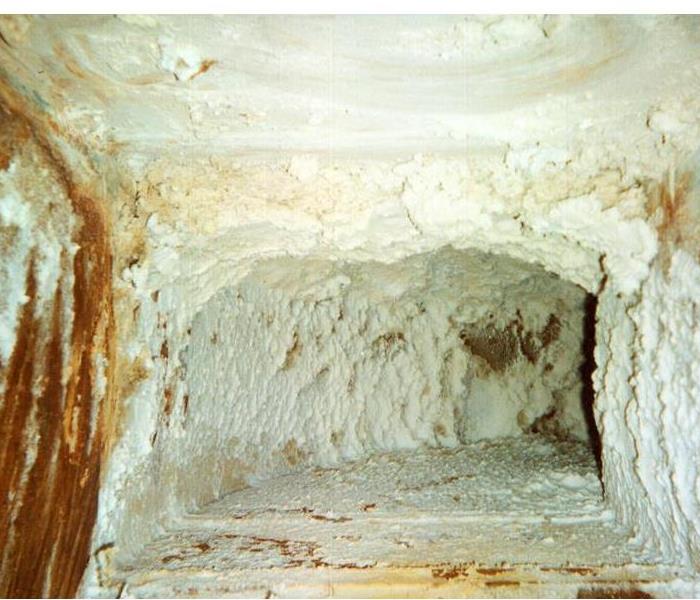 Keeping your HVAC units clean and well maintained can decrease the odds of your unit experiencing a fire.
Keeping your HVAC units clean and well maintained can decrease the odds of your unit experiencing a fire.
The first time you turned on your HVAC in Springfield or Greene County this season, you may have anticipated two things; the warmth that would stop your feet from freezing, and the assurance that the unit would work for another season. But to guarantee that those two things would happen, your unit should be regularly maintained. Doing so not only confirms you’ll be warm this winter but can also keep you safe from dangerous and destructive fires.
Fire Hazards Near Your Furnace
A furnace is usually installed in a utility closest, garage, or basement, places that are also often used as storage areas. Because of that, many items may end up too close to the heating equipment, causing a fire hazard. To keep this from happening, there should be a 6’ radius clear zone around your HVAC unit. This is especially important for flammable items such as:
- Rags
- Clothing
- Paper
- Cleaning chemicals
- Gasoline
- Paint
- Kerosene
Fire Hazards in Your Furnace
Don’t panic! Your heating unit is safe, if it’s well maintained. But according to the National Fire Protection Association, heating equipment fires are the second leading cause of home fires, and nearly half of the fires in Springfield and Greene County that occur in December, January, and February.
Here are ways to decrease the odds that your HVAC unit will experience a fire:
- Change the air filter every three months. When it gets too dirty, air flow is restricted, causing your furnace to not only work less efficiently, but may eventually cause the motor to overheat.
- Have professional maintenance done on your HVAC unit yearly. They’ll check for and fix items such as faulty parts or bad wiring, which can cause the voltage to go too high. They’ll also check the bearings. When they’re tight, worn or dry, motor bearings can catch heat and eventually catch fire.
SERVPRO of Springfield / Greene County professionals routinely inspect heating, ventilation and air conditioning units. Keeping them clean can extend the life of the equipment.
Fire Hazards Due to Gas Leaks
If you use gas to heat your home, a gas leak could occur. This might happen if gas lines or certain furnace components are damaged or faulty. Gas line safety is critical to fire safety, as gas leaks cause natural gas to build up in the home, and could cause a fire or explosion. Throughout the cold season, be aware of the signs of a gas leak and call for furnace repair immediately if you experience:
- The smell of sulfur or rotten eggs
- High gas bills with no other explanation
- Difficulty breathing
- Drowsiness or fatigue
- Nose bleeds
- Dizziness
There’s an old saying that you should hope for the best but plan for the worst. So, keep a fire extinguisher in your kitchen and near any heating equipment, and make sure each room has a working smoke detector. And by having SERVPRO regularly maintain your HVAC unit, it’ll not only save you money, but may also save your life by preventing furnace fires.
After the Fire: What to Save, What to Toss
7/9/2019 (Permalink)
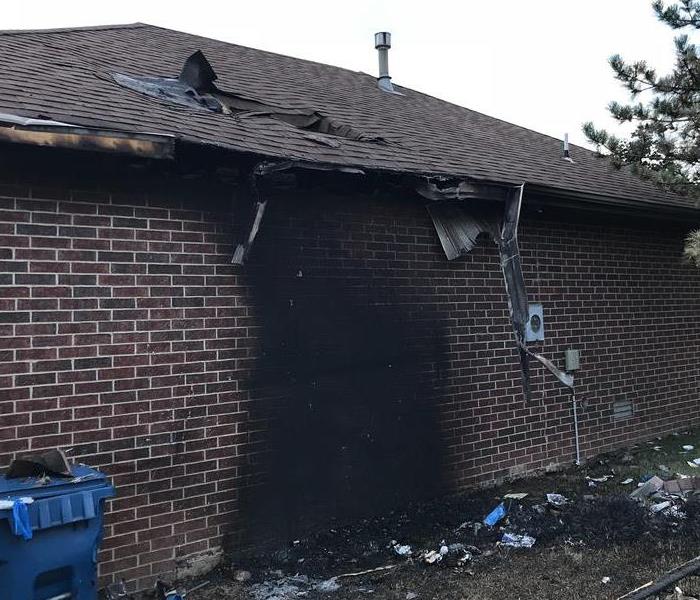 A local home damaged by fire and restored by SERVPRO of Springfield/Greene County.
A local home damaged by fire and restored by SERVPRO of Springfield/Greene County.
One of the hardest tasks to deal with after a fire is deciding what you can keep and what to toss. Many objects are obvious losses, but others may leave you unsure whether they’re salvageable or not. You want to save money, yet you also need to stay safe. So, here are some tips on how to handle some of the more questionable items that have been exposed to fire and smoke:
Food
Throw out all food that’s been in contact with smoke and/or firefighting chemicals, including fresh produce, meat, poultry, fish, eggs, opened containers and packages, food packaged in cardboard, foil, paper, plastic, cloth, screw-topped jars and canisters, and any foods stored outside the refrigerator that were exposed to smoke or fumes.
Some canned goods may still look good on the outside, but heat damage can re-cook the ingredients in the can. This activates bacteria that causes food spoilage, making them unhealthy to eat.
But aren’t foods that were in a refrigerator or freezer be safe?
Sometimes seals on those appliances aren’t air-tight and smoke can leak inside to damage food. If the electricity went out during the fire for more than 2 hours, then it’s likely spoilage occurred so all items should be discarded.
Medicines & Cosmetics
The Center for Drug Evaluation and Research (CDER) says the effectiveness of drugs can be destroyed by high temperatures from a fire. If you think your medicines have been exposed to excessive heat, consider replacing them. The same is true if they’ve come into contact with firefighting chemicals.
As to cosmetics, high heat can change their composition without showing any visible signs. They could end up damaging hair and skin. Plus, they can absorb the toxic fumes that go along with all fires, which is not anything you want to put on your skin.
Clothing
Clothes, bedding, and other fabrics can often be salvaged after a fire with proper cleaning and disinfecting. However, if anything is burned, throw it away. Use even stricter judgment when considering your child’s or baby’s clothing as they’re more susceptible to any leftover toxic residue.
But what about clothes that were packed in plastic bags and stored inside of drawers and closed closets? Aren’t they safe from smoke residue and odor?
No. Rapidly expanding air during a fire easily penetrates clothing even when plastic covers are used to protect them. As the air inside cools down and fresh air begins to circulate, garments covered by plastic with the odor inside are not subject to the normal airing-out process. This allows the malodors to thoroughly penetrate the garment.
To add to the problem, the plastic itself will attract and retain odor to a considerable degree and so must be removed and disposed of ASAP.
Never try to salvage any possessions that could put your health at risk. When in doubt, throw it out! If you have any other questions or concerns about what can be salvaged after a fire, or if you need to schedule fire restoration services, please contact SERVPRO of Springfield / Greene County today.
SERVPRO of Springfield/Greene County Fire Damage Restoration Services
6/14/2019 (Permalink)
 A Smoke and Water Damaged Kitchen
A Smoke and Water Damaged Kitchen
Smoke and Soot Damage Can Cause a Pervasive Odor in Your Springfield/Greene County Home.
Smoke and soot is very invasive and can penetrate various cavities within your home, causing hidden damage and odor. Our smoke damage expertise and experience allows us to inspect and accurately assess the extent of the damage to develop a comprehensive plan of action.
Smoke and soot facts:
- Hot smoke migrates to cooler areas and upper levels of a structure.
- Smoke flows around plumbing systems, seeping through the holes used by pipes to go from floor to floor.
- The type of smoke may greatly affect the restoration process.
Different Types of Smoke
There are two different types of smoke–wet and dry. As a result, there are different types of soot residue after a fire. Before restoration begins, SERVPRO of Springfield/Greene County will test the soot to determine which type of smoke damage occurred. The cleaning procedures will then be based on the information identified during pretesting. Here is some additional information:
Wet Smoke – Plastic and Rubber
- Low heat, smoldering, pungent odor, sticky, smeary. Smoke webs are more difficult to clean.
Dry Smoke – Paper and Wood
- Fast burning, high temperatures, heat rises therefore smoke rises.
Protein Fire Residue – Produced by evaporation of material rather than from a fire
- Virtually invisible, discolors paints and varnishes, extreme pungent odor.
Our Fire Damage Restoration Services
Since each smoke and fire damage situation is a little different, each one requires a unique solution tailored for the specific conditions. We have the equipment, expertise, and experience to restore your fire and smoke damage. We will also treat your family with empathy and respect and your property with care.
Have Questions about Fire, Smoke, or Soot Damage?
Call Us Today – 417-865-7711
Fire: Dangers in the Aftermath
3/20/2019 (Permalink)
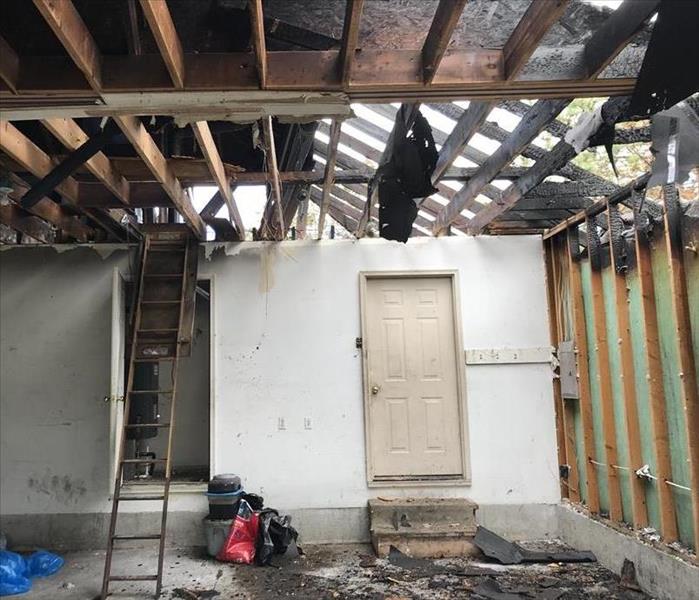 Fire Damaged Garage from a recent residential fire SERVPRO of Springfield/Greene County completed
Fire Damaged Garage from a recent residential fire SERVPRO of Springfield/Greene County completed
There’s been a fire at your home or business. Once the firemen leave, your first inclination may be to go inside the structure to see what you can salvage and start the cleaning process. But cleaning up after a fire is much more complicated than regular cleaning. It’s also very dangerous. Because once the last flame has been snuffed out, the dangers from a fire continue.
Soot Hazards
Since fire destroys all materials, the soot that covers everything you touch and that you kick up in the air is full of toxic substances. That’s why the highly trained professionals at SERVPRO of Springfield / Greene County wear heavy duty personal protection equipment (PPE) on fire mitigation jobs until all the soot is removed. Here are some of the poisons found in the soot and ashes of a building fire:
- Mesothelioma (cancer) causing asbestos fibers from building materials
- Carbon materials can produce carbon monoxide, ammonia, and nitrogen oxides
- PVC can create hydrogen chloride, phosgene (used as a chemical weapon during World War I), dioxin, Refrigerant-40, bromomethane (a pesticide), etc.
- Hydrogen sulfide and sulfur dioxide (poisonous gasses)
- Petroleum based items can produce formaldehyde, acrolein, furfural, cresols, and other harmful chemicals
- Even wood smoke releases more than 100 chemicals also found in cigarette smoke
Removing the Odors
One of the main aftereffects of a fire are odors. These can be difficult to remove without professional know-how and equipment. For instance, did you know that several factors can impact the strength of fire odors? Some of these are:
- Size - The bigger the fire, the more objects have burned, and thus there’s been more smoke.
- Length -The longer a structure has been exposed to smoke, the more deeply odor has seeped into porous materials.
- Space - When a fire occurs in a smaller room, the smoke odor becomes more intense and concentrated.
- Stuff - Not all odors are equal. For instance, burning wood, plastic and protein, all emit different smells with varied consistency.
SERVPRO of Springfield / Greene County has the knowledge and equipment to eliminate the diverse and pungent odors that occur after a fire. Besides the easily accessible areas, we also examine wall cavities, duct work, crawl spaces and plumbing chases to establish whether they also suffered any smoke or fire damage. We’ll ensure that they’re cleaned, repaired and that all traces of odor are removed.
So as tempting as it may be to rush back into your fire damaged home or business once the fire is out, play it safe and call SERVPRO of Springfield / Greene County first so that we can safely make it “Like it never even happened."
Fire Damage Do's and Don'ts
10/23/2018 (Permalink)
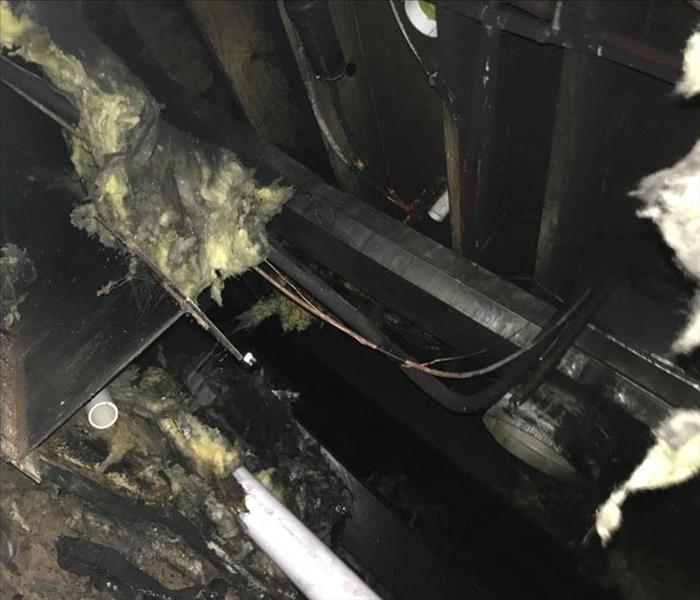 Fire in Crawl Space Causes Smoke Damage in Springfield home.
Fire in Crawl Space Causes Smoke Damage in Springfield home.
Emergency Fire Damage Tips
DO
- Keep hands clean
- Limit movement in the home to prevent further damage.
- Place dry, colorfast towels or old linens on carpeted traffic areas to prevent more soiling.
- If electricity is off, empty freezer and refrigerator and prop doors open.
- Wipe soot from chrome on faucets and appliances then protect with a light coating of lubricant.
DON'T
- Don't attempt to wash any walls or painted surfaces or shampoo carpet or upholstery without contacting us.
- Don't attempt to clean any electrical appliances that may have been close to fire, heat or water without consulting an authorized repair service.
- Don't use any canned or packaged food or beverages that may have been stored near the fire, heat or water.
- Don't turn on ceiling fixtures if ceiling is wet. The wiring may be damaged.
- Don't send garments to an ordinary dry cleaner. Improper cleaning may set smoke odor.
After any fire damage situation, your primary focus should be safety first:
- Is it safe to stay in the house?
- Electrical and "slip and fall" hazards are some of the most prevalent concerns.
- Only do activities that are safe for you to perform.
- Wet materials can be VERY heavy. Be careful!
Every fire damage event is a little different, and requires a unique solution, call SERVPRO of Springfield/Greene County at 417-865-7711 we can help assess your situation!
The Top 10 Ways to Avoid Fires
10/19/2018 (Permalink)
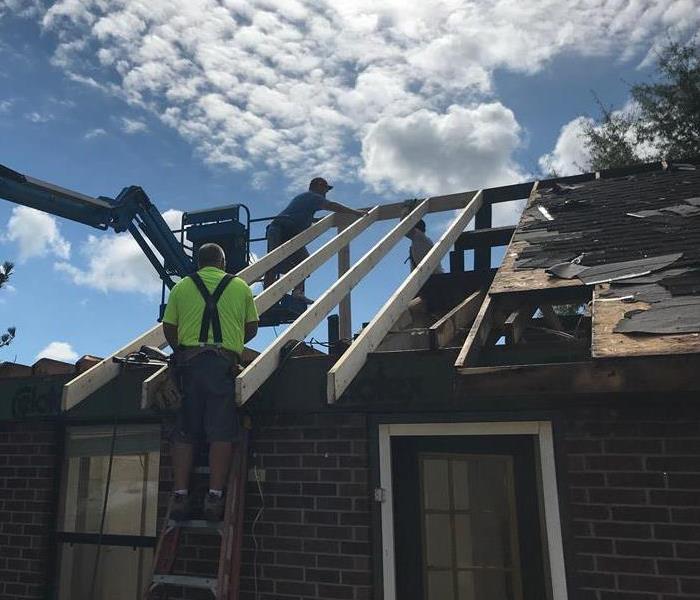 A recent garage fire that caused significant damage to a Springfield home.
A recent garage fire that caused significant damage to a Springfield home.
Fires will always happen, but we prefer that you personally never have to experience one! If you do, click here for some after the fire do’s and don’ts while waiting for help to arrive.
Fires devastate homes and businesses and cause damage in numerous ways. Not only is fire destructive, but it also leaves behind lingering and pervasive odors, not to mention extensive water damage that results from the firefighter’s efforts to extinguish the flames. The professionals at SERVPRO® of Springfield/Greene County have the specialized training, equipment and experience that will restore your home or place of work to preloss conditions.
To increase the odds that you’ll stay safe, consider these Top 10 causes of fire. Use this information to plan how to make your home or business a safer place:
- Cooking: Avoid splattering grease, never leave kitchens unattended and keep flammable materials away from heat sources.
- Heating Equipment: Have your furnace checked regularly and keep portable heaters away from combustibles.
- Smoking: If you smoke in or near the house, always make sure the cigarette butt is fully put out and make the bedroom off-limits to smoking.
- Electricity: Look out for frayed cords, the overuse of extension cords and overloaded outlets, and don’t run electrical wires under rugs or heavy furniture.
- Candles: Never leave them unattended and keep them out of the reach of children or pets.
- Children: Keep them away from matches and lighters to suppress any curiosity they may have about what happens when different items burn.
- Inadequate wiring: It’s often found in older homes and apartments. Have a professional electrician check yours.
- Flammable Liquids: Keep fuels, solvents, cleaning agents, thinners, adhesives, and paints away from heat sources.
- Holiday Decor: Keep your Christmas tree well-watered and away from heat sources. Check decorative lights for damage and never place candles on or near Christmas trees.
- Grills: Keep them away from your home, deck rails, tablecloths and tree limbs. And never use them indoors, including your garage.
SERVPRO® of Springfield/Greene County has the knowledge, professional equipment and ability to eliminate all traces of a fire. Besides the easily accessible areas, we also examine wall cavities, duct work, crawl spaces and plumbing chases to establish whether they also suffered any smoke or fire damage. We ensure that all fire damage is cleaned, repaired, or removed and leave your home or business as if it never even happened.
SERVPRO of Springfield recognizes Fire Prevention Week
5/15/2018 (Permalink)
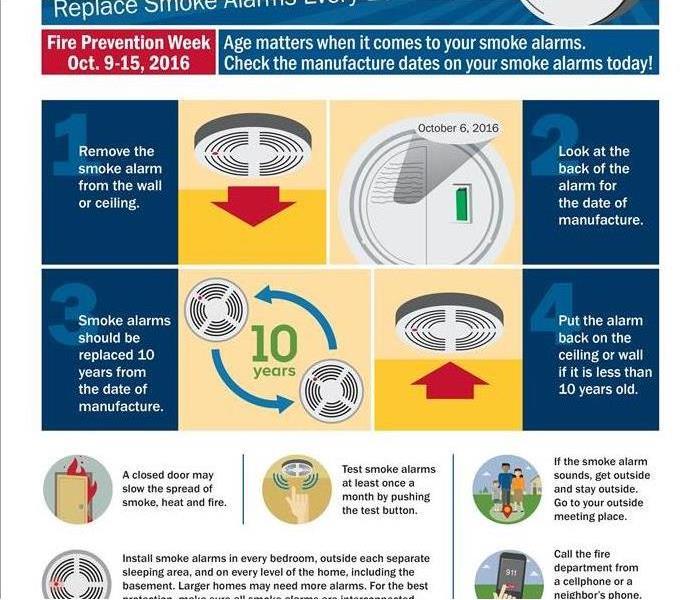 SERVPRO of Springfield recognizes Fire Prevention Week
SERVPRO of Springfield recognizes Fire Prevention Week
This year’s Fire Prevention Week campaign, “Don’t Wait – Check the Date! Replace Smoke Alarms Every 10 Years,” represents the final year of our three-year effort to educate the public about basic but essential elements of smoke alarm safety.
Why focus on smoke alarms three years in a row? Because NFPA’s survey data shows that the public has many misconceptions about smoke alarms, which may put them at increased risk in the event of a home fire. For example, only a small percentage of people know how old their smoke alarms are, or how often they need to be replaced.
As a result of those and related findings, we’re addressing smoke alarm replacement this year with a focus on these key messages:
- Smoke alarms should be replaced every 10 years.
- Make sure you know how old all the smoke alarms are in your home.
- To find out how old a smoke alarm is, look at the date of manufacture on the back of the alarm; the alarm should be replaced 10 years from that date.
http://www.fpw.org/
SERVPRO of Springfield recognizes Fire Prevention Week
5/10/2018 (Permalink)
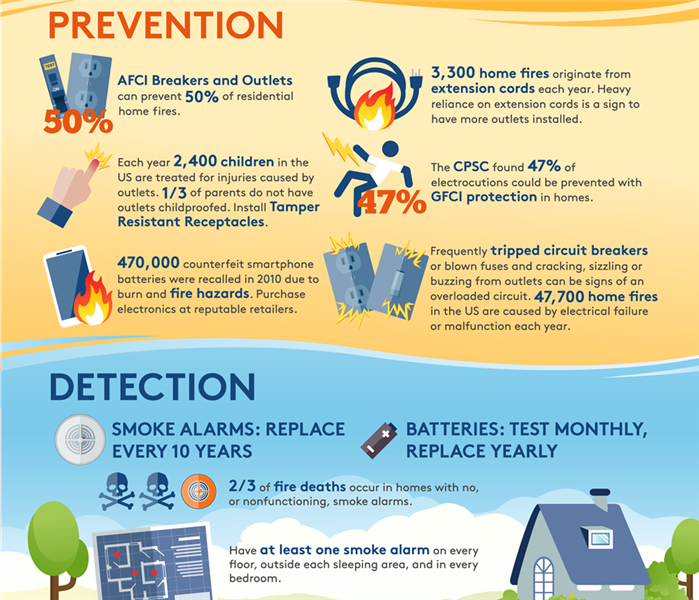 SERVPRO of Springfield recognizes Fire Prevention Week
SERVPRO of Springfield recognizes Fire Prevention Week
This year’s Fire Prevention Week campaign, “Don’t Wait – Check the Date! Replace Smoke Alarms Every 10 Years,” represents the final year of our three-year effort to educate the public about basic but essential elements of smoke alarm safety.
Why focus on smoke alarms three years in a row? Because NFPA’s survey data shows that the public has many misconceptions about smoke alarms, which may put them at increased risk in the event of a home fire. For example, only a small percentage of people know how old their smoke alarms are, or how often they need to be replaced.
As a result of those and related findings, we’re addressing smoke alarm replacement this year with a focus on these key messages:
- Smoke alarms should be replaced every 10 years.
- Make sure you know how old all the smoke alarms are in your home.
- To find out how old a smoke alarm is, look at the date of manufacture on the back of the alarm; the alarm should be replaced 10 years from that date.
http://www.fpw.org/





 24/7 Emergency Service
24/7 Emergency Service








